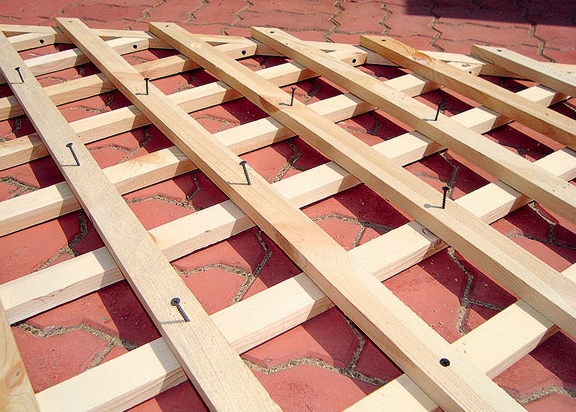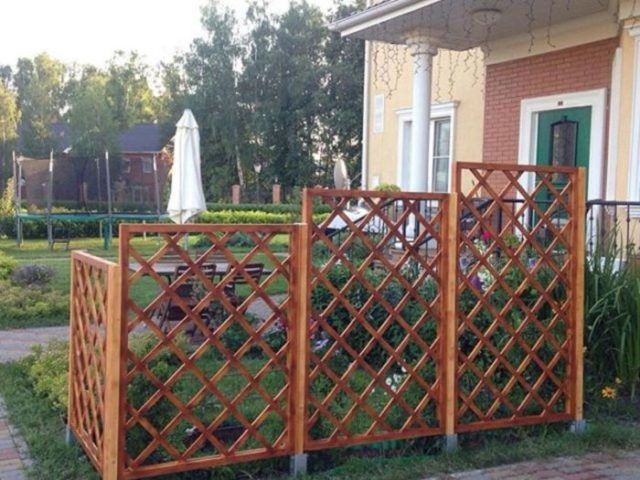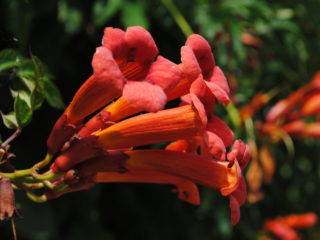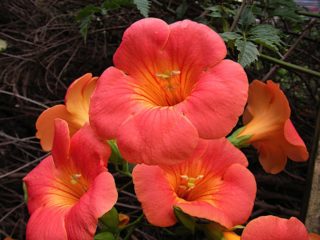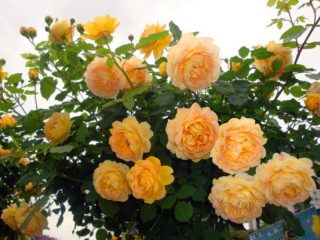Content
Planting and caring for Kampsis in European gardens and parks began in the 17th century. This deciduous vine, belonging to the Bignoniaceae family, loves warm climates. Its name translated from Greek means “to twist, bend.” One of the features of Kampsis is the formation of large, bright inflorescences.
Features of growing vines
Campsis is usually planted in garden plots and park areas for vertical gardening. The plant has aerial roots that cling to supports. And the foliage has a decorative appearance thanks to large, complex plates of 7-11 leaflets with serrated edges. During the flowering period - from June to September - paniculate inflorescences about 9 cm long and 5 cm in diameter are formed on the vine. Their color can be pink, crimson, red, orange.Although the flowers of the plant do not emit a scent, they attract insects: wasps, bees, flies, ants.
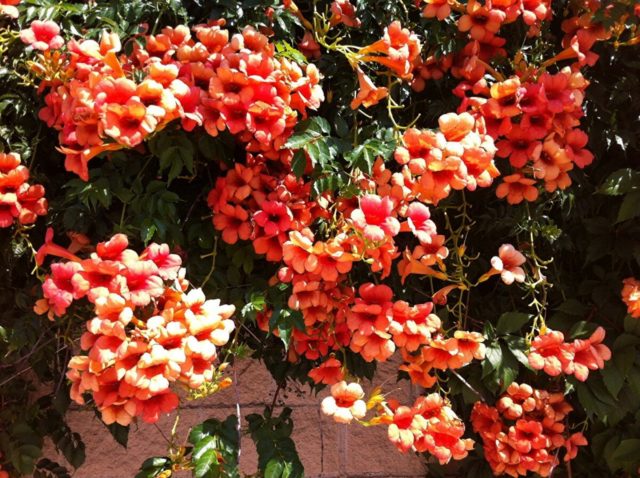
Campsis is considered a honey plant
The fruits are elongated pods up to 10 cm in size with a large number of membranous seeds with wings. Ripe specimens crack and the grains scatter over a considerable distance.
Growing and caring for campsis in open ground gives gardeners virtually no worries. The only problem they face is the lack of flowering. Most often this is due to the age of the plant or low air temperature. In regions with cool climates, the vine survives, but rarely blooms.
Rules for planting Kampsis
When starting to plant and care for campsis in open ground, it is necessary to take into account that seedlings obtained from seeds do not always reproduce the characteristics of the mother plants. Despite good germination, this method of propagation is rarely used. In addition, the first flowering occurs only after 5 years, and sometimes later. In order for a vine to inherit varietal characteristics, it must be grown from cuttings. Flowering usually occurs in the third year of life.
Recommended timing
The best time to transfer seedlings to open ground is April and May, or the end of August and September. Even when planting Kampsis in the fall, it has enough time to adapt. But it is recommended to postpone such work to the end of the growing season in regions with a warm climate.
Site selection and preparation
The condition for abundant and long flowering of Kampsis is a sufficient amount of sunlight. When a vine grows in the shade, its inflorescences become small and pale.Therefore, the preferred place for planting campsis is open space, which is protected from the wind on the north and west sides.
Campsis does not tolerate high humidity. It should not be grown in areas with shallow groundwater. And in the southern regions, where dry periods alternate with heavy precipitation, the vine should be given a place on a flat area so that moisture evenly flows to the roots of the plant and does not stagnate.
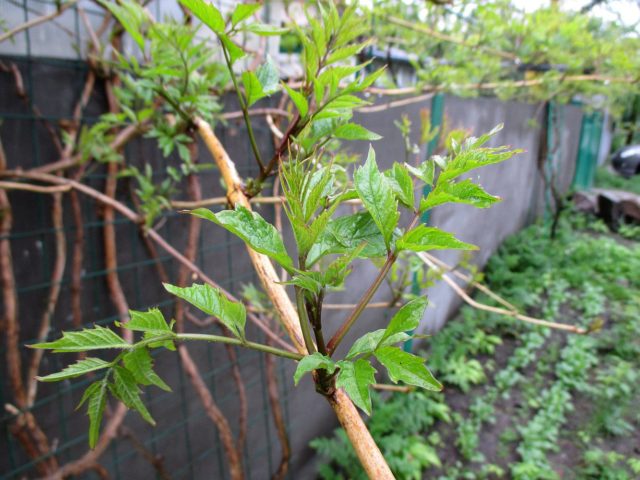
Cuttings for propagating Kampsis should be taken from abundantly flowering, healthy plants.
How to plant Kampsis
The planting process is not labor intensive. In order to eventually get a decorative vine on your site, you need to:
- Prepare a planting hole 50 cm wide and about 40 cm deep. For spring planting, this should be taken care of in the fall. The soil from the pit is mixed with humus, and about 500 g of complex fertilizer is added. If the soil in the area is heavy, add a drainage layer up to 10 cm thick.
- On the day of planting, a low mound is made at the bottom of the hole.
- The Kampsis stalk along with the earthen lump is transferred to a new place and placed on a mound, the roots are straightened.
- Sprinkle with soil, making sure that the root collar of the vine rises 5 cm above the soil level.
- Carry out abundant watering. One plant requires 5-8 liters of water.
- A support is placed nearby and the campsis is tied up.
- The soil is mulched.
How to care for Kampsis
Liana care includes standard agrotechnical operations:
- watering;
- fertilization;
- prevention of diseases and pests;
- pruning;
- weeding;
- preparation for the winter period.
Watering and fertilizing schedule
Being able to withstand periods of drought, Kampsis loves water. You can water it immediately after the top layer of soil dries out. But it is better to protect the vine’s root system from overwatering, as it can rot.
Lianas growing on fertile soils do not need fertilizing. If the soil is poor in minerals, then in early spring it is fertilized with nitrogen and phosphorus compounds. A single application of plant fertilizer is usually sufficient for the entire season.
Installation of capsis supports
Seedlings need staking, and all vines, regardless of age, require support. This can be a wall of a house, a fence, a gazebo, or arched wooden or metal structures or trellises.
Some craftsmen make decorative portable supports for campsis from thin slats with their own hands:
- Make a rectangular frame and fasten it with self-tapping screws. Along the long side, slats are placed at equal distances, running in a diagonal direction parallel to each other.
- On the back side of the frame, slats directed in the opposite direction are attached in the same way. They are fastened together for strength.
- The top is coated with varnish or compounds that protect the wood from rotting.
Weeding and loosening
These procedures ensure active growth and development of the vine. It is especially important to loosen the Campsis tree trunk if it grows on heavy, dense soil.
Pruning Kampsis
Pruning is an important part of caring for a rapidly growing vine, a way to regulate its growth.In addition, this is an opportunity to get lush flowering, since buds develop only on new shoots.
The time for pruning is spring, before buds form, and autumn. Principles of the procedure:
- Several of the strongest shoots are selected from the vine, and the rest are cut off with pruning shears.
- Such operations are carried out over 3-4 years until the trunk grows to the desired height.
- Then lignified branches and 3-4 young ones are left, which are shortened to 3 buds.
- If the main trunk is damaged, it is removed and replaced with the most powerful shoot.
- In summer, faded branches of the plant are also pruned into 3-4 buds. This allows you to maintain a decorative appearance throughout the entire flowering period.
The nuances of spring pruning of Kampsis on video.
Preparing Kampsis for winter
In regions with mild winters, there is no need to cover the vine. If the air temperature drops to -20 degrees or lower, the plant cannot survive the frost without additional protection. Both the root system and shoots require shelter. In autumn, Kampsis is pruned, leaving only the skeletal and main branches. Then they are removed from the support, placed on the ground, covered with sawdust and spruce branches, and polyethylene on top.
There is another way to prepare the campsis for winter, without removing it from the vertical support. The roots are sprinkled with sand and covered with leaves or spruce branches. The shoots are wrapped with lutrasil, folded in several layers, then with plastic film.
The nuances of growing in the regions
Caring for heat-loving vines in regions with different weather and climatic conditions has its own characteristics. The gardener must take them into account.
In outskirts of Moscow
For cultivation in the Moscow region, you should choose the following varieties of Kampsis:
- taking root;
- hybrid.
The best time for planting is late May or early June.
In the middle zone
The liana is frost-resistant, so planting and caring for campsis in the middle zone does not cause difficulties for gardeners. The seedlings are transferred to open ground in May. During the season, standard agrotechnical operations are performed. For the winter, the branches of the vine are carefully laid on the ground and a shelter is built. With proper care, Kampsis blooms profusely.
In the Urals
In the Urals, campsis planting begins in early summer. Plants lack warmth and may suffer from frost. For this reason, gardeners often fail to achieve flowering. During the winter, the vine needs shelter.
In Siberia
Cold winters with temperatures down to -40 degrees determine the characteristics of growing Kampsis in Siberia. This region is considered unfavorable for the plant. It is recommended to plant it in greenhouses or winter gardens.
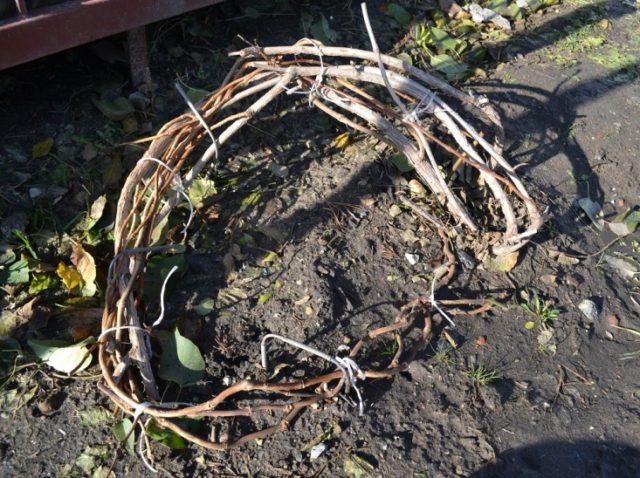
In open ground, the vine does not tolerate frost well.
Problems during cultivation
Difficulties in maintaining Kampsis are most often associated with the lack of flowering and the appearance of diseases. Pests rarely attack the crop.
List of reasons why Kampsis does not bloom
In some cases, gardeners are unable to get the vine to bloom. This can be caused by several reasons:
- Plant age. Campsis begin to bloom 3 years after planting when propagated by cuttings and after 5 years when propagated by seed. And specimens that have reached 10 years old usually stop blooming and require complete pruning for rejuvenation.
- Lack of lighting.Lianas kept in shaded areas become very elongated, which deprives them of the strength necessary to form buds.
- Excess nitrogen fertilizers. Their application activates the growth of green mass. Kampsis cannot bloom. To correct the situation, plants are fed with phosphorus compounds or bone meal.
- Spring frosts. Low temperatures damage the buds, from which young flowering shoots should form.
- Incorrect trimming time. The plant must be “trimmed” in late autumn or early spring, before young shoots appear.
- Cold weather in spring and summer. This interferes with the formation of buds.
Diseases and pests
Liana has strong immunity. However, improper care often provokes diseases.
Diseases | Reasons for appearance | Signs | Treatment |
Bacterial rot | Excess moisture or infection with pathogenic bacteria | Darkening of the petioles of leaves and shoots, softening and wateriness of the leaf plates of the plant | Removal of affected parts of campsis, treatment with fungicides |
Fungal infections | Cool weather combined with high humidity | Dark gray and brown spots on leaves | Spraying vines with Bordeaux mixture and fungicides |
Viral infection |
| Lack of flowering, yellow rough spots on the leaves of Kampsis | Removing the affected parts or all plants completely, spraying with copper sulfate |
Among the insect pests that attack Kampsis, the most common is aphids. It usually appears in dry weather or with excessive use of nitrogen fertilizers. Insecticides are used to control aphids.
How to get rid of Kampsis on the site
Once having planted a liana on the site, many gardeners after a few years wonder how to destroy the root system of the campsis flower. It tends to grow quickly over a large area.
To prevent the problem, it is necessary to fence off the trunk circle of each plant. For this you can use sheets of metal or slate. They must be dug to a depth of 80 cm into the ground so that the diameter of the circle is 3–4 m.
Conclusion
Planting and caring for campsis is an easy way to decorate an area with a perennial vine. It looks great against the backdrop of gazebos and terraces, log and brick walls, along fences and on arches. But when planting a plant, it is necessary to fence off its near-trunk circle so that the Kampsis shoots do not overrun the area.

